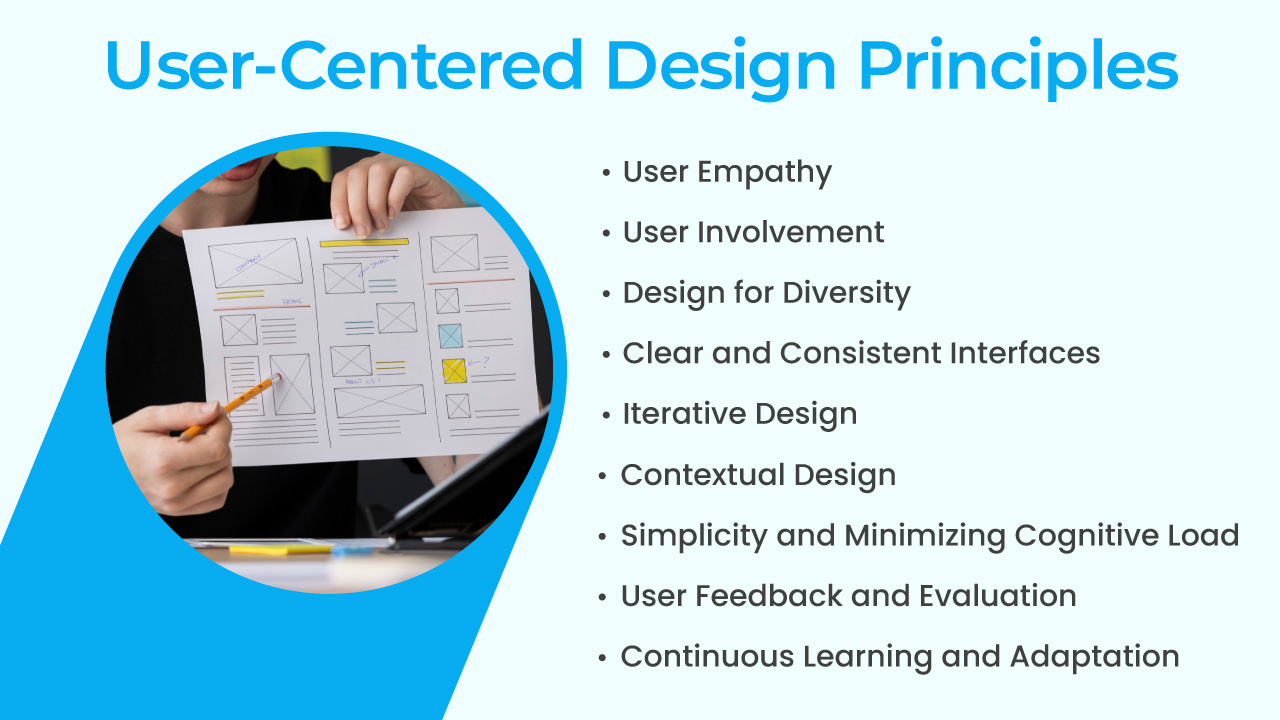Beyond Good Design: Exploring the Principles of User-Centered Design

Imagine you’re an architect with the task of designing a house. Instead of blindly guessing what the residents might want, you become an investigative detective. You sit with them, ask questions, and listen attentively to their desires, needs, and dreams. You want to understand how they’ll use the house, what makes them comfortable, and what brings them joy.
You gather a team of skilled craftsmen, from carpenters to painters, and share the insights you gained from your conversations. You brainstorm and sketch out various ideas that cater to the residents’ unique tastes and preferences.
As you progress, you constantly involve the residents, giving them a sneak peek at the designs and prototypes. Their feedback becomes your guiding star, helping you refine and polish the house to its perfection.
In the end, you’ve created a house that is more than just bricks and mortar. It’s a sanctuary perfectly tailored to its inhabitants—where they feel understood, comfortable, and delighted at every turn.
User-Centered Design is the magic that brings this vision to life, weaving the desires of the users into every aspect of the design process.
Why is User-Centered Design Important?
- Meets User Needs: UCD puts the needs, goals, and users’ preferences at the forefront. By understanding and incorporating user requirements into the design process, UCD ensures that the final product or service addresses their specific needs effectively. It leads to higher user satisfaction and increases the chances of adoption and success in the market.
- Enhances Usability: Usability is a crucial aspect of any product or service. UCD focuses on creating designs that are intuitive, easy to use, and efficient. By involving users in the design process and conducting usability testing, UCD helps identify and address usability issues early on, resulting in a more usable and user-friendly solution.
- Reduces Errors and Frustration: A poorly designed product or service can lead to user frustration and errors. UCD aims to minimize these issues by designing interfaces and interactions that are clear, consistent, and aligned with user expectations. By reducing user frustration and errors, UCD improves the overall user experience and increases user confidence in the product.
- Increases Efficiency and Productivity: UCD aims to optimize the workflow and tasks of users. By understanding their context, goals, and challenges, UCD helps design interfaces and features that support efficient and productive usage. It leads to time savings, improved task completion rates, and increased user efficiency.
- Reduces Development Costs and Iterations: Incorporating user feedback and involving users in the design process from the start helps identify usability issues and design flaws early on. It reduces the need for costly redesigns, rework, and iterations during later stages of development. UCD saves time and resources by ensuring the final product meets user expectations.
- Drives Innovation: User-centered approaches encourage designers and developers to think creatively and come up with innovative solutions that address user needs. By understanding users’ challenges and aspirations, UCD uncovers new opportunities for improvement, leading to innovative and market-leading products or services.
- Builds User Loyalty and Advocacy: A positive user experience is crucial for building user loyalty and advocacy. UCD helps create products and services that resonate with users, exceed their expectations, and make their lives easier. It can lead to increased user satisfaction, loyalty, and positive word-of-mouth recommendations, which are valuable for long-term success and growth.
In summary, User-Centered Design is important because it ensures that the end product or service is designed with users in mind, resulting in improved usability, user satisfaction, efficiency, and business success. By prioritizing the needs and preferences of users, organizations can build products that truly meet user requirements and stand out in the market.

- User Empathy: Designers should empathize with users to understand their perspectives, challenges, and motivations. By putting themselves in the users’ shoes, designers can create designs that meet user needs and provide a positive user experience.
- User Involvement: Users should be actively involved throughout the design process. Their input and feedback are valuable for understanding their needs, goals, and preferences. Regular user research, usability testing, and iterative design cycles ensure continuous user involvement and validation.
- Design for Diversity: UCD understands that users with diverse characteristics, backgrounds, and abilities. Designers should consider inclusivity and accessibility in their designs to accommodate a wide range of users. It involves designing for different demographics, cultural contexts, languages, and physical or cognitive abilities.
- Clear and Consistent Interfaces: UCD emphasizes clear and consistent interface design to enhance usability. Designers should create interfaces that are intuitive, easy to understand, and consistent in layout, terminology, and interaction patterns. It reduces user confusion and improves learnability.
- Iterative Design: UCD embraces an iterative design process involving multiple design iterations and feedback loops with users. It allows for continuous improvement and refinement of the design based on user input and usability testing. Iterative design helps address usability issues early on and leads to better design outcomes.
- Contextual Design: Understanding the users’ environment, tasks, and workflows helps create designs that align with their real-world needs and challenges. It ensures the design fits seamlessly into their lives and enhances their overall experience.
- Simplicity and Minimizing Cognitive Load: UCD promotes simplicity in design to reduce cognitive load on users. By minimizing unnecessary complexity, distractions, and cognitive demands, designers can create designs that are easier to understand, navigate, and use.
- User Feedback and Evaluation: UCD emphasizes the importance of user feedback and evaluation throughout the design process. Usability testing, surveys, interviews, and other evaluation methods provide valuable insights into how users interact with the design and identify areas for improvement.
- Continuous Learning and Adaptation: UCD encourages a mindset of continuous learning and adaptation. Designers should embrace feedback, data, and user insights to inform ongoing design decisions and future iterations. It allows continuous improvement and keeps the design aligned with evolving user needs.
In today’s digital landscape, User-Centered Design (UCD) plays a crucial role in creating successful and user-friendly applications. Black Widow Tech understands the significance of UCD and is committed to delivering user-centric designed apps that add value to our clients and their users.
At Black Widow Tech, we embrace the principles of UCD throughout our development process. We recognize the importance of user involvement and empathy, ensuring that we deeply understand our client’s users and their unique needs. By conducting thorough user research, usability testing, and iterative design cycles, we gather valuable insights that shape our designs and lead to optimal user experiences.
Our team of talented designers and developers works closely with clients to incorporate user feedback and iterate on the design. We believe in the power of collaboration, combining our expertise with the client’s domain knowledge to create applications that resonate with the target users.
Black Widow Tech also values diversity and inclusivity in our designs. We strive to build applications that cater to a wide range of users, considering different abilities, cultural contexts, and demographics. By ensuring accessibility and inclusivity in our designs, we create experiences that are usable and enjoyable for all.
Moreover, we emphasize clear and consistent interfaces, simplifying the user experience and reducing cognitive load. Through contextual design, we deeply understand the users’ environment, tasks, and workflows, enabling us to develop applications that seamlessly integrate into their daily lives.
By partnering with Black Widow Tech – a top mobile app development company in USA, clients can expect to receive applications that go beyond meeting functional requirements. Our user-centric approach ensures that the end product not only meets user needs but also exceeds their expectations. We deliver value by enhancing usability, efficiency, and user satisfaction, leading to increased engagement and business success. With Black Widow Tech’s expertise and commitment to UCD principles, clients can be confident that their applications will stand out in the market, delight users, and drive long-term success.
